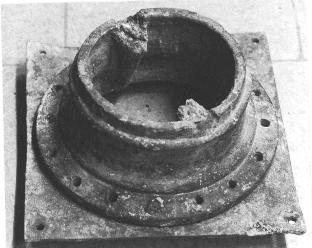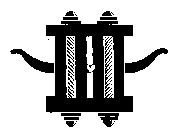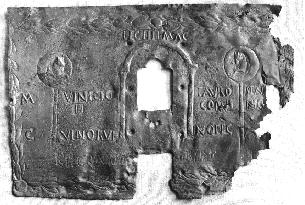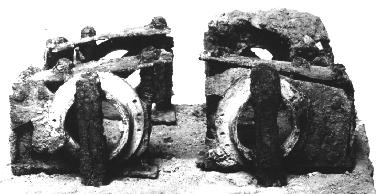 Cremona
Cremona  Hatra
Hatra
Bronze modiolus, diam. 13.6 cm. Bronze modiolus (diam. 28 cm) resting on bronze counterplate.
Produced AD 45 in Mogontiacum (Mainz) Mid third century AD
 CATAPULTS IN GREEK AND ROMAN
ANTIQUITY
CATAPULTS IN GREEK AND ROMAN
ANTIQUITY
ARCHAEOLOGICAL FINDS
Modiolus
This page presents some typical
finds of catapult components. The construction timbers of catapults are
always gone, only metal components have been preserved. Most common among
the finds is the modiolus, greek choinix (Marsden 1969 &
1971: "washer"). On each end of a torsion spring there was such a modiolusfor
holding the elastic rope coil of the spring. Therefore in a
two-armed catapult there are always four modioli, two for every
spring. Indeed, many finds come with sets of four identical modioli.
Until now about 60 modioli have been found. Nearly all of them have been
made from heavy cast bronze, with the Lyon modioli as the only exception
(forged iron).
 Cremona
Cremona  Hatra
Hatra
Bronze modiolus, diam. 13.6
cm.
Bronze modiolus (diam. 28 cm) resting on bronze counterplate.
Produced AD 45 in Mogontiacum
(Mainz) Mid third century AD
Protective cover of torsion springs
 Cremona
catapult
Cremona
catapult
bronze, width of cover 22 cm, with
inscription:
legionis IIII Macedonicae. M.
Vinicio II, Tauro Statilio Corvino consulibus, C. Vibio Rufino legato,
C. Horatio ...o principe praetorii (ILS 2283)
"Catapult of legio IIII Macedonica.
Built when M. Vinicius again and Taurus Statilius Corvinus were consuls
(AD 45) under the governor (of the province Germania superior) C.
Vibius Rufinus through C. Horatius ...o, chief of staff".
Complete metal fittings
of catapult frame
 Ampurias
(Spain)
Ampurias
(Spain)
Iron fittings
of catapult frame with four bronze modioli (only two visible). Ca.
100 BC.
for
details, see Bibliography
Back
© D. Baatz, D-64297
Darmstadt, Germany
Vers. 14 November,
2000